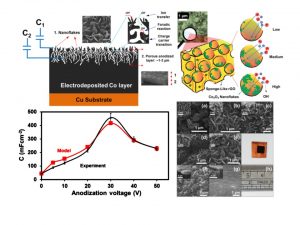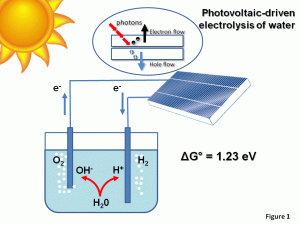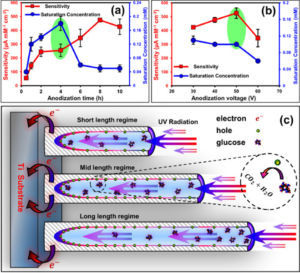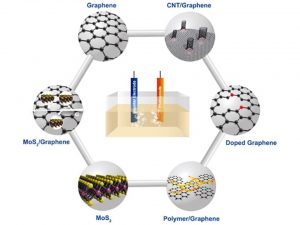Research Interests
Here, a brief story about our current research topics in “Health” and “Energy” area is presented. More details can be found in introduced text books or review papers on each page.

Solar Hydrogen Production from Water
The alarming depletion rate of reserved fossil fuel associated with rapid increase in environmental pollution has caused an urgent need to develop efficient clean and renewable energy resources. In this regard, many different approaches have been followed up. The sun is a free, clean, sustainable and easy access energy source, and the solar produced hydrogen, which can be used in fuel cells to generate electricity or changed directly in combustion engines, makes no pollution except water. Hence, to obtain hydrogen as a clean energy carrier, the scenario of a renewable hydrogen economy has attracted much attention from researchers recently. Because …
Read More
Read More

Nanomaterials for Energy Storage Applications
Supercapacitor devices are well-known as their fast charge storage kinetics by the electric double-layer capacitance (EDLC) or EDLC-like mechanisms at the electrode/electrolyte interfaces. So far, research groups worldwide have been mostly worked on the electrodes consist of carbon-based (e.g. porous carbon, graphene, curved graphene nanosheets, graphene nanoribbons, carbide-derived carbon and etc.), two dimensional layered (e.g. Ti3C2Tx MXene) and transition metal oxide/sulfides/phosphates (e.g. MnO2, Co3O4 and etc.) materials. The former stores charge by the adsorption of electrolyte ions onto the surface of the electrode materials providing high power density. The two latter ones store charge by fast redox reactions presenting an …
Read More
Read More

Additive Manufacturing/ Printing of Devices
Today, due to emerging 4th industrial revolution (I 4.0), additive manufacturing methods for fabricating a variety of devices are very attractive. Besides different techniques like PBF, DIW, SLA, FDM, ink-jet printing (IJP) provides a powerful tool for the fabrication of functional devices with high accuracy. The operating principle of IJP technique is close to the direct ink writing (DIW) process. In these techniques, stable and homogeneous inks with desired rheological properties are formulated by dispersing active material in a liquid medium. Despite the similarities, the rheological properties of developed inks for each of these methods are different. Here, some papers …
Read More
Read More

Earth Abundant Electro-catalysts for Red/Ox Reactions
Considering the depletion of hydrocarbon reservoirs and adverse effects of their combustion, providing a renewable and environmentally friendly resource of energy is necessary for human societies. Photoelectrochemical (PEC) and electrochemical (EC) water splitting into O2 and H2 at the surface of a proper material (photoactive semiconductor or electrocatalysts) is a promising solution to produce solar fuel as a green and sustainable source of energy. In both these approaches, each half-reaction, oxygen evolution reaction (OER) and hydrogen evolution reaction (HER), must be optimized to achieve the highest efficiency. The challenging step is the OER since its Gibbs free energy is 1.23 …
Read More
Read More

Machine Assisted Approaches for Material Design and Device Fabrication
Useful information on this subject can be found in informative published papers like: 1- Mai et al. Machine Learning for Electrocatalyst and Photocatalyst Design and Discovery, Chemical Reviews, 2022. 2- Esterhuizen et al. Interpretable machine learning for knowledge generation in heterogeneous catalysis, Nature Catalysts, 2022. 3- Chen et al. Recent progress toward catalyst properties, performance, and prediction with data-driven methods, Current Opinion in Chemical Engineering, 2022. 4- Liu et al. Finding physical insights in catalysis with machine learning, Current Opinion in Chemical Engineering, 2022. 5- Gaviria et al. Machine learning in photovoltaic systems: A review, Renewable Energy, 2022. 6- Oviedo …
Read More
Read More

Bio-medical Application of Nanomaterials
A particularly alarming issue in world health today is the rise and prevalence of antibiotic-resistant bacteria, which significantly increases death rates and costs of treatment; and a group of pathogens responsible for the majority of hospital acquired infections. On 27 February 2017, WHO published list of bacteria for which new antibiotics are urgently needed. Although the Gram-positive bacteria in the ESKAPE group, including the methicillin-resistant Staphylococcus aureus, have rightly drawn attention over the past decade, infections caused by the Gram-negative microbes have recently been recognized as a more critical healthcare issue. One the other hand, detecting bacteria and other pathogenic …
Read More
Read More

2D Nanomaterials for Catalytic Reactions
The 2D materials are generally composed of strong covalent bonds leading to in-plane stability and weak van der Waals bonds, which sustain the stacked layer structure. Following the discovery of graphene in 2004, a new horizon has opened up for exploring other 2D layered materials such as transition metal dichalcogenides (TMD), transition metal oxides, graphitic carbon nitride (GCN), and hexagonal boron nitride (h-BN). These 2D materials can be integrated with a three dimensional (3D) SC material as a new building block to fabricate interfacial heterostructures. The electrocatalytic activity of this material strongly depends on its quality and morphology. For instance, defects and …
Read More
Read More
